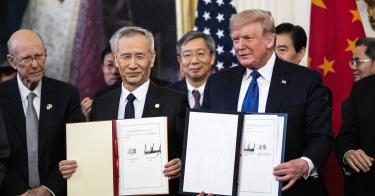President Donald Trump and Chinese Vice Premier Liu He on Wednesday signed Phase 1 of the U.S.-China Economic and Trade Agreement.
The long-awaited deal is the result of two years of tough trade negotiations between Washington and Beijing.
Over this period, new taxes have been placed on hundreds of billions of traded goods across the Pacific as the U.S.-China trade war escalated. This led American importers to pay roughly $43 billion in new taxes, not to mention the cost to American farmers of losing market access to China.
Now, the new Phase 1 deal takes a significant step toward normalizing the U.S.-China trade relationship as it’s easily the most comprehensive agreement our countries have signed since China’s entry into the World Trade Organization.
American companies’ access to China’s market, the protection of their intellectual property rights, and ability to do business free from Chinese government coercion long has been a concern of the Trump administration.
The Phase 1 deal attempts to address these concerns by implementing procedures to protect American intellectual property and stopping the forced transfer of trade secrets to Chinese entities.
The agreement also opens up new opportunities for U.S. farm and agriculture exporters by removing nontariff barriers to China’s market.
The deal includes commitments by China to increase its purchases of U.S. agriculture, manufactured, and energy goods and services by $200 billion over two years. Although the agreement attempts to shift China’s political economy to a more market-based one, free from government intervention, there is nothing market-based about these government-directed purchases.
The Phase 1 deal, while not perfect, is a step in the right direction and we should welcome the swift conclusion of a Phase 2 deal and removal of all tariffs levied over the past two years.
In December, the Trump administration announced it would hold off on new tariffs on roughly $160 billion worth of imports, and halve the tariff rate Feb. 14 on roughly $120 billion worth of imports from China as part of the Phase 1 agreement.
But until a Phase 2 deal is concluded, Americans will continue to shoulder the cost of tariffs on up to $370 billion worth of imports from China.
This piece originally appeared in The Daily Signal





